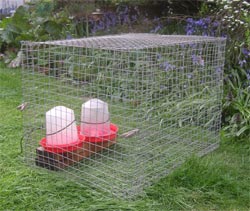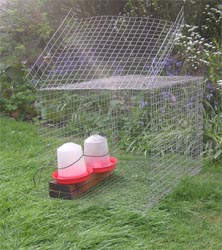How to make a broody coop to stop your chickens and bantams being broody (takes 1 hour to make)
Posted by Fiona Nevile in Chickens | 130 comments “Two of my hens are broody.” Bunty was exasperated.
“Two of my hens are broody.” Bunty was exasperated.
“We’ve got a broody one too.”
This was our first summer of keeping bantams (a small friendly breed of chicken).
Bunty continued, “I wish I hadn’t suggested Bantams. I’ve discovered that they go broody at the drop of a hat.”
Years ago Bunty had kept chickens commercially. Those were a type of chicken bred for laying that rarely go broody.
She thought that she had the answer to our dilemna.
“We need anti broody coops. You’re good at making things. Why don’t you make a couple?”
My heart sank. I thought that they would take hours to make, imagining a sort of dog kennel with a wide gauge wire mesh floor.
To stop a hen being broody you need to stop her from settling comfortably. The trick is to construct a cage with a floor made of large wire mesh ( with at least 1 inches squares). Set the cage on bricks so that the floor is suspended, keeping the bricks to the outside edges so that she can’t sit on them. Provide a small drinking fountain and feeder within the cage and pop her in. She won’t be able to settle on the wire mesh floor and within a few days will get over her broodiness.
I went to bed early and woke at four. In the still cold light I realised that the entire cage could be made of wire mesh. I went to the garden centre after breakfast and bought three sheets of wire mesh measuring 90cm x 60cm. The cage is 60 cm long and 43 cm high and 43 cm wide This allows for an overlap at the joins.
Our broody coop is simple to make. Lay the wire on a flat surface, and bend 2 cm of wire mesh to a 90 degree angle along a 60 cm side. Then lift the opposite end and press it into the angled flap. Press firmly on the bulgy end and fold flat to make a clean angle and pull the ends apart. You now have the floor and one side. Repeat the operation for the roof and the other side.The flap may seem a bit fiddly but it makes the cage much more rigid and stable.
Now attach the the two halves together to make the body of the cage. I tied the two together with twists of wire at 5cm intervals. The front and back of the cage are made from the remaining sheet. Hold the sheet against the opening at the back and cut to fit using wire clippers. The back was attached using wire twists. The front is hinged at the top with sides that bend back a bit over the sides of the cage.
Having a hinge at the top makes it easier to put the chicken in the cage. If you put her in headfirst you can quickly drop the door down and secure it with pegs before she has turned around. We used clothes pegs but small bulldog clips would be good for a larger chicken.

The broody coop in the photo is the mark one version. I made Bunty a Rolls Royce (mark two) cage out of plastic coated wire. Definitely worth the extra investment as it’s stronger and more durable. Carol (our Maran) has never been broody. If she was, I’d make her a bigger cage (the hen needs to be able to stand up). And it would have to be stronger than the mark one cage as she is a much larger bird than the bantams.
Our broody coop sits in the Day Centre. Bunty had hers in the run with a bit of wood as a roof.
It took me a while to realise when the perfect moment of release should take place. The chicken in the broody coop will ask to be released immediately. But bide your time. Her comb will gradually change from pink to red. When it is red she can get out of jail. If you release her while her comb is still pink she will nip back to the nesting box and you will have to start the process all over again.
If you have a broody chicken and you want her to sit on fertilised eggs put a floor on the bottom of the broody coop, fold the door over the roof and you have a quiet area in which she can sit for twenty one days, with easy access to food and water. She needs to be able to move away from the nest so don’t lock her in. Ideally, place the cage somewhere that is protected from the elements. Or construct a simple roof like Bunty did (a bit of plywood slightly bigger than the cage). It’s not a good idea to let a broody hen stay in the nesting box as it puts the other hens off laying eggs.
Leave a reply






Hi,
One of my Hens, Gladys, has gone really broody and is quite aggresive if I try to move her. (my husband had to hold her back with a garden rake so I could remove the eggs from under her). She’s now sitting on nothing but she still refuses to budge. I’m worried that she’ll go into a rage if I put her in a broody coop. You don’t think she could hurt herself in there as long as I make the coop big enough do you?
I really hope the broody coop works for me as none of my other hens are laying apart from 1 soft shell and I rely on my eggs for my cake business! Thanks ever so much for the inspiration! I’m off to B&Q now…!
I have a hen who has been in a rabbit hutch where she layed her eggs – unbeknown to me. They have now hatched and are getting quite big (4 babies and mum). I want to know the best way of moving them back to a new hen coup. I was going to take the hutch away so they don’t head back in there and I don’t want them going and roosting in the tree (as the rooster does) as we are coming into winter now. (new Zealand)
Any ideas would be great – Sue
Hi, I have a broody light sussex, she has been sitting on eggs fo about 2 days in the normal nest box in the chicken house and i am wondering if i should move her? If so when and where to, do i need to make her another house?
Please help
Emma.
Hi,
We made a broody coop today as we have 4 broody hens at the moment. We have started off just putting two in there. Is it ok to put a perch in there cause they look so uncomfortable and we dont want them to get sore feet!
Thanks Katie
Hi Katie
The whole idea is that the hens don’t settle. This will take them out of their broody state.
No perch. Just the cage and food and water.
Cool! I was worried about my chickens going broody too quickly. This is perfect, thanks!
Hello how are you doing my name is larrt mike pls i will like to know of you have hen coops for sell i will like to know the cost of it plux the tax and get back to me i will be waiting to hear from you very soon
Thanks for your advice on broody hens. We have had hens for 3 years now and last year had a broody hen who didn’t lay for the entire season. Despite reading all our books on henkeeping, we were not given any information on what to do to bring her out of her broodiness. We only ‘cured’ her by putting fertilised eggs under her which she did hatch successfully – although we then couldn’t bear to part with the chicks so ended up with 6 girls instead of our original 3! Unfortunately this week the same mother hen has gone broody again which upsets the other hens as she steals their eggs to sit on and will not leave the nest. We are so grateful to have such brilliant advice on building the cage as in all three years of henkeeping we have never seen such practical advice on any website or in any book.
Once again, many thanks
Hi Sue
I discovered this method from my friend Bunty, who in her seventies had experienced wartime chicken keeping. Delighted that you found the information useful!
Very many thanks for all this information.
We got 2 hens 5 months ago, adding 2 more in October (who were just pre-lay)- and one of these has just gone broody over Christmas, and is certainly disrupting the house routine !
We shall now see what we can do about a broody-coop……….
Hi,
Just an update on our broody light sussex. We wound up popping her into the old coop for four days and changed her food and water daily. With the concrete floor she wasn’t comfortable at trying to brood, and often roosted on a besser block in the corner. Anyway, the solution worked perfectly and she began laying again a week after we’d let her out.
Hi Vicki
I haven’t heard of hens thinking that they are cockerals! Poor you it sounds like a nightmare. Hope that you sort it out soon.
Hi Paul
Your light sussex needs to be put into a broody coup (as described in the post above). This need to be off the ground so that she can’t settle. This is the quickest and kindest way to deal with the condition. Putting her in a shed may take some time and probably won’t work.